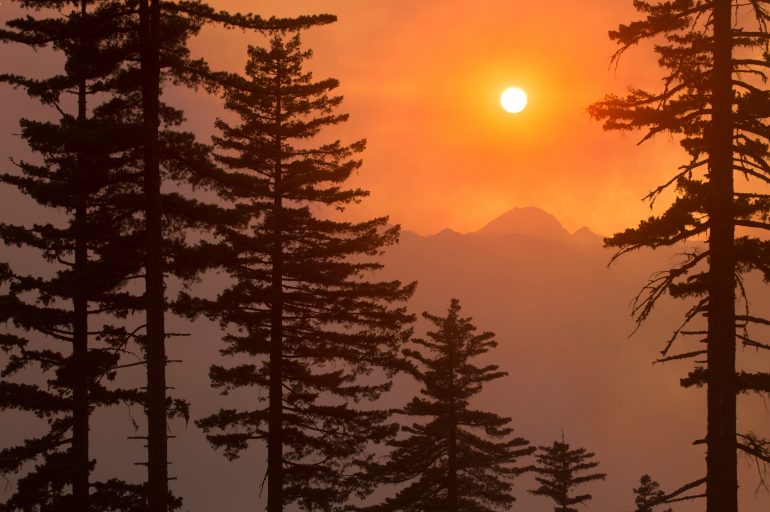One week was all we had to drive from Texas to Oregon. Everything was on a schedule, from stops and our stays to our meals and highway exits. Shelby split every mile with me; we would take turns driving, sometimes as short as 20 minutes a turn at our sleepiest. It was as much a mission to get my Mazda up to Portland as it was a road trip full of discovery, sleep-deprivation, and wonder. Through west Texas, Arizona, New Mexico, we drove through the deserts whose sun-soaked lands slowly became familiar; then we headed north up through lanky California.
After spending the night in Arcata, CA, we set out to finish the last nine hours of the trip. We set out on highway CA-299 east, otherwise known as Trinity highway, then north up Klamath river highway. Driving on windy roads alongside valleys and rivers, through lush green under blues skies without a cloud, we certainly took the scenic route and it was time-consuming. We drove over an hour in thick forestry without seeing much of anyone. To us, Happy Camp was just another “intersection town,” so to speak, having only about 1,000 residents. We would pass through without so much as stopping for gas. The sun was setting past the skyline as we started to leave Happy Camp. As we headed up and up the hills of Greyback Road, snow patches began to crop up; fewer than five minutes later, after we curved around a bend in the road, we come to a full stop. We sat staring at what was no longer a road but now simply part of the forest reclaimed by the snow. In a hazy and mild panic, we doubled back toward the Kingfisher Market—an establishment much like an overgrown convenience store. After kindly asking the cashier for alternative routes to I-5, we were convinced the only way out of this corner was back, the exact way we came.
With nothing left to do but accept our sleep-deprived fate, we bought cold sandwiches and sushi from the market’s tiny deli. As we sat atop the car’s hood out in the lot, we began to notice the town’s texture and feel. There was a giant Sasquatch statue down the road we hadn’t originally questioned. The banner posted in front read “No Monument,” which suddenly puzzled us now that we sat stranded in the sun eating our ridiculously chewy food. “What’s that mean, anyways,” we wondered. Unbeknownst to us, this was the beginning of a deeper understanding for Happy Camp and its culture, its identity, and what sustains its vitality. Like anybody else from the city simply passing through, we hardly had a chance to get acquainted with Happy Camp. It wasn’t until we were nearly stranded, finding just enough time to really gaze and listen to how much there was, despite the town’s small size, that we began to understand.
When we finally stopped driving, the feeling that only we were moving as we passed through seemingly static landscapes ceased. I began to notice how the town itself was moving: residents out gardening and maintaining their homes, the coming and going of cars through the Kingfisher Market parking lot. Though it took some research to see it, there was even a movement as Happy Camp aged through history. Happy Camp used to be fueled by the logging industry in the ‘80s, and it’s easy to see how the industry shaped the town’s culture. Many families were raised on the industry’s money, and like anything that might’ve supported the community’s living, the residents respected it. Over time, logging came to be something to stand by and be proud of for many locals. If nothing else, logging was the way for them to have a sense of shared identity.
All that changed when timber companies faced restrictions under the Endangered Species Act in 1994, which protected the spotted owl’s natural habitat in surrounding areas. This restricted the industry enough that the mill was forced to close. In 2010, Happy Camp faced another challenge: a memo leaked by the Department of Interior Design proposed a national monument in the area, the very same one that “No Monument” signs targeted. Such a monument would further land use restrictions, only this time on mining. Over the course of these changes, the remaining residents have resided in a sort of shell of what the town used to be. Now there’s a clear dilemma: on one hand, environmentally progressive California and federal politicians push for restrictions, and see it as much needed environmental protection; on the other hand, people of Happy Camp see these restrictions as the government’s interference and disregard for the local community’s needs. When logging and mining are not just critical to a town, but sustain its very existence, what can we say of the town when these industries are lost? And, what can we say of the perspectives of the people that have only ever known Happy Camp?
It’s easy to wonder: how can people not care for the environment when forests have been severely shrunk and glaciers are melting, among so many other large-scale catastrophes? And similarly, the finite nature of coal means it’s destined as an industry to perish—so how can people vote for Trump, who is anchored in this coal-mining mentality? The very act of asking questions like these demonstrates our biases shaped by the cultures in which we are rooted. To the extent that Happy Camp has its own culture, residents would neither share these biases nor sympathy for such interests, at least in the way we do. If these questions are posed rhetorically without the need for an answer, it’s because they don’t open an avenue for investigation but rather reassert liberal environmental values to those who already accept that line of thinking. Understanding the mentality of those that oppose progressive climate policies and support industries like coal can begin with understanding a place like Happy Camp: a community who has been made to feel marginalized, and maybe even sacrificed, as collateral damage for the greater good. It’s very likely that the people on this side of environmental issues see the value and beauty of the environment–they do, after all, spend their lives immersed in it. But when policies neither seek their input nor offer alternative solutions that protect their livelihoods, the line dividing opinions seems simple: protection for loggers, their families, their livelihoods… or protection for the environment, liberal politicians, and the city tourists enjoying the forest at their leisure.
Spending just two short hours trying to find a way out of Happy Camp means Shelby and I are the latter. We were tourists with no intention of stopping in Happy Camp, as it has no restaurants or hotels for accommodating tourists and travelers, and hardly even showed up on our atlas. The brief time we spent did little to support Happy Camp’s economy, of course, but it did begin to reveal just how deep the town’s needs run. Happy Camp is losing residents as they move away in search for work elsewhere, and there are no signs of investment in new industries. Without a turn in a new economic direction, the future looks grim for Happy Camp. Nevertheless, the voice of a dying community becomes all the more important in, if nothing else, understanding the opposition to progressive environmental changes and hopefully addressing the needs that Happy Camp’s voice raises.
This article originally appeared in our May / April 2018 print issue.





